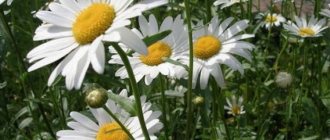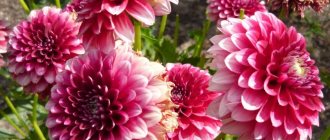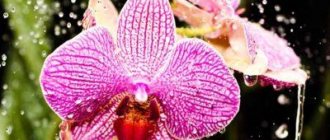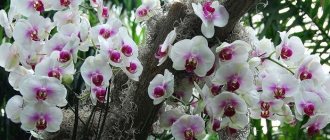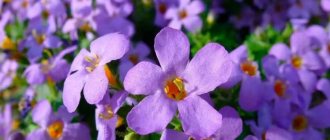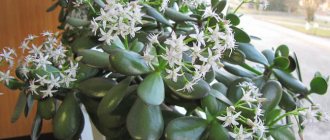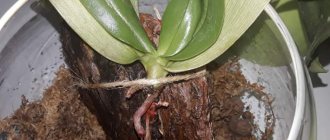Plants » Flowers
0
3614
Article rating
Kira Stoletova
Phalaenopsis has won the hearts of many gardeners; it is a flower of unique beauty; with proper care, it blooms widely and for a long time. The flowering time of an orchid is about 2 months, and can be repeated 2-3 times a year.
Orchid flowering period at home
Flowering at home
An orchid requires special conditions to bloom. Each variety has its own requirements for care at home and its own flowering time.
A flower younger than 1.5 years old does not bloom; it lacks the strength to produce a peduncle. By 1.5-2 years, the plant should have at least 6 leaves.
The flowering time of an orchid is 6 months. The lifespan of flowers is no more than 3 months, and they are replaced during the flowering process. The plant does not have a clearly defined period of rest and is not tied to the season.
How long does it last?
Flowering time in most cases depends on the age of the plant, its type, and comfortable conditions. It can range from 2 to 6-8 months. It is believed that one flower on a stem lasts about 3-4 weeks, and the difference between the opening of buds can be a month or more.
Attention! The longest flowering variety is Phalaenopsis. In adulthood, this plant can bloom all year round, throwing out new flower stalks in turn.
Be sure to provide the plant with long-term lighting, at least 12 hours. Otherwise, it may drop flowers.
The necessary conditions
Orchids bloom from 3 to 6 months a year. Factors influencing the growing season and the number of flowers:
- temperature regime;
- lighting;
- watering and humidity;
- flower age;
- root system care;
- stress experienced during transplantation or illness.
The growing season of flowers often takes place in the summer, the peduncle grows in the fall, and by winter the orchid blooms. It happens that the plant produces a second flower stalk in the spring, and it will bloom in the summer.
When does this period begin?
Different varieties prefer their own time of year, and it doesn’t have to be summer when the plant blooms. The flowering period is individual for each plant type:
- In phalaenopsis and paphidopellum, this period is considered to be winter - November-March.
- Cymbidiums and dendrobiums will delight you from October to February, and with proper care, maybe even in the summer.
- Cattleya blooms from spring to early winter.
- Oncidium – April-June.
- Miltassia and miltonia bloom in spring or autumn.
But experienced flower growers also deceive the plants and, by creating favorable conditions, achieve flowering in a different period.
Temperature and lighting
Orchids should bloom several times a year at temperatures of 25°C during the day and up to 18°C at night.
In the summer, take the pot with the plant to the balcony, do not keep it in a stuffy box. Protect the phalaenopsis from direct sunlight and avoid drafts. Orchids bloom only when there is a temperature difference.
The flower is comfortable on the eastern windowsill in the warm season, and on the southern one in the cold season. In the cold season, the daylight hours are short, so in the evening they use a fluorescent lamp; it is worth illuminating the very top, otherwise it will not form and bloom.
Is it possible to extend?
Regulating the process of formation and appearance of buds is not an easy task. Much depends on how to care for the plant when it blooms. There are basic care rules that should be followed to achieve the desired result. The main parameters are daylight hours and air temperature. Changing these factors accordingly makes it possible to stimulate flowering, the formation of buds, and then stop or accelerate the blooming of flowers. A long flowering stage can be achieved with diligent and careful monitoring.
- Adding daylight is the first sign to prepare for the start of flowering. A sudden lack of lighting will immediately affect the condition of the orchid and the development of buds. A minimum of 12 hours of daylight is required, only in this case long flowering is possible. During the cold season, it is recommended to use artificial lighting. The quality of lighting also matters. Orchids prefer partial shade, diffused light. Bright, scorching rays can only do harm and speed up flowering.
- At the usual night air temperature of +18°C, flowers bloom faster, and to prolong this process, the temperature should be lowered to +15°C; this will also extend the flowering period.
For a correct, full-fledged flowering process, another factor is important - the temperature difference, which should be 4°C. Important! Hot air is unacceptable; the orchid should be in a cool place.
Secondary factors must also be taken into account:
- good ventilation in the room;
- watering with high-quality, warm water;
- fertilizing with potassium fertilizers once a week;
- moisturize every week;
- exclude transplants and spraying.
Thus, taken together, the fundamental factors make it possible to provoke the formation of buds, prolong current flowering as much as possible and prolong future flowering. However, all this is possible only with the great desire and diligence of the orchid owner. Love your plants and they will certainly love you back.
Substrate selection and root care
Suitable soil for orchids is one that contains bark and moss. Before planting, the substrate is soaked for a day, then washed and allowed to drain off excess water.
The roots of the flower are actively involved in photosynthesis and need light, so a transparent plastic pot with drainage holes is suitable for better air exchange and water drainage.
Trim dry and rotten roots in a timely manner using sterile pruning shears. Always treat cut areas with an antiseptic or crushed activated carbon.
Regularly fertilize the soil
Before transplanting, carefully remove the flower and clean it of the substrate. Place the plant in a pot, cover the roots with substrate and bark, lay moss on top, it will retain moisture in the soil. Transplantation is carried out only in the dormant stage or immediately after flowering. The orchid will need a little time to adapt.
It is important to fertilize the soil in a timely manner. Any flower shop sells a mixture suitable for orchids. It is used according to the instructions. The flower is fertilized during the dormant period, which is when the plant accumulates strength for the next flowering.
What does the deadline depend on?
The quality and frequency of inflorescence formation is influenced by a number of factors.
- Moving the plant. Orchids do not like to be moved or rearranged. At the same time, they experience a kind of stress. Also for exotics, the position relative to the sun is important; even when watering, it is better not to mix the pot. Otherwise, the orchid may react by shedding buds, leaves, and yellowing of the peduncle (what to do if the orchid does not bloom at all?).
- There is not enough sunlight. Incorrect placement of the pot plays a direct role. Flowers prefer bright, but not scorching, light, as well as daylight hours of 14 hours. During unfavorable periods or the autumn-winter period, the plant requires additional lighting. Without light, the tip of the orchid begins to dry out, and its overall development slows down. For these purposes, phyto lamps are used, which shine intensely but do not dry out the air.
- Low air humidity. High air temperature and low humidity are dangerous parameters for plant life. The moisture evaporates quickly enough through the leaves, but the roots do not have time to nourish in time. A process of withering occurs, followed by drying out of foliage, flowers, and root systems. The maximum humidity level is 30-40%.
- Illiterate selection of nutrients. I would like to note that for the growth and lush green color of leaves, fertilizers with a high nitrogen content are used. On the contrary, for bright and lush flowering, mineral preparations based on potassium and phosphorus should be used. Just be careful when fertilizing; you can’t pour nutrient solutions directly onto the roots, as such actions can cause burns to the root system. Before applying mineral components, the soil should be slightly moistened.
- A sharp change in temperature and humidity conditions , the flower being in a draft. Daily ventilation has a positive effect on the condition of the orchid. But ventilation and draft are two different things. A draft is dangerous even for people, not to mention plants. Cold air flow can cause limp flowers. It is not recommended to ventilate if the plant has just been watered or sprayed.
- Condition of the root system. Roots are an important organ in the life cycle of orchids. They take part in the process of photosynthesis. To do this, they also need sunlight, so it is better to plant the plant in transparent plastic containers.
- Watering with cold water. This factor can negatively affect the condition of the root system. Cold water supercools the roots, which is fraught with the development of rotting processes, as well as the sudden fall of buds.
- Incorrect watering. A lack of fluid can occur in the complete absence of watering.
Important! The plant vitally needs a minimum volume of water, which dissolves the minerals in the soil and nourishes the root system. If there is insufficient moisture, the flowers wither and fall off, and the same thing happens with the peduncle.
Peduncle formation
Peduncle is a shoot on which buds are formed. Often it is barely distinguishable from a young root and grows in different directions.
The peduncle is formed in the axils of the leaves, has a sharp tip, on which scales are already visible. It is important not to disturb the orchid with transplants or movements during this period, and not to provoke stress.
Duration of development
Orchid blooms at home in late autumn. Sometimes, simultaneously with the peduncle, phalaenopsis produces a young leaf.
Flowering occurs in several stages:
- the flower produces buds first;
- then the inflorescences bloom.
The break between them is 1.5-2 months. Only an adult flower can bloom long and beautifully. The small orchid has not yet gained the strength to form a peduncle. Additional stimulation will harm it and the plant will die.
Drying of the peduncle
This is a natural process that indicates the end of flowering.
Watch it for a while: when all the buds are dry, the peduncle is removed. Using a sterile pruning shears, carefully cut off the shoot, leaving a small stump at the base, and treat the cut area with crushed activated carbon.
When the orchid rests and regains its strength, it will begin to bloom again.
Why doesn't the orchid bloom?
Mostly people buy already flowering specimens, but it also happens that they buy a plant without buds. It’s good if it releases a flower arrow after some time, but sometimes the waiting period is prolonged. A possible reason could be the youth of the plant. Different types of orchids bloom at the age of 1 to 3 years. For a plant to bloom, it must have 5 to 8 leaves.
The second reason for the reluctance to bloom is too calm and comfortable life. Of course, all lovers of indoor plants provide their pets with the best conditions. Therefore, they see no reason to reproduce. To make the exotic beauty bloom, give it a little shock: move it to another place, reduce watering, provide a contrast between day and night temperatures.
You can learn more about how to make an orchid bloom from this video:
Stimulation of growth
You need to know when to water and how
If the plant does not bloom for a long time, you can take the following actions:
- Reduce watering for 2 weeks;
- Reduce temperature to 16°C.
After this, a peduncle appears from the dormant bud. They also use ready-made liquids - growth stimulants, spray them according to the instructions.
